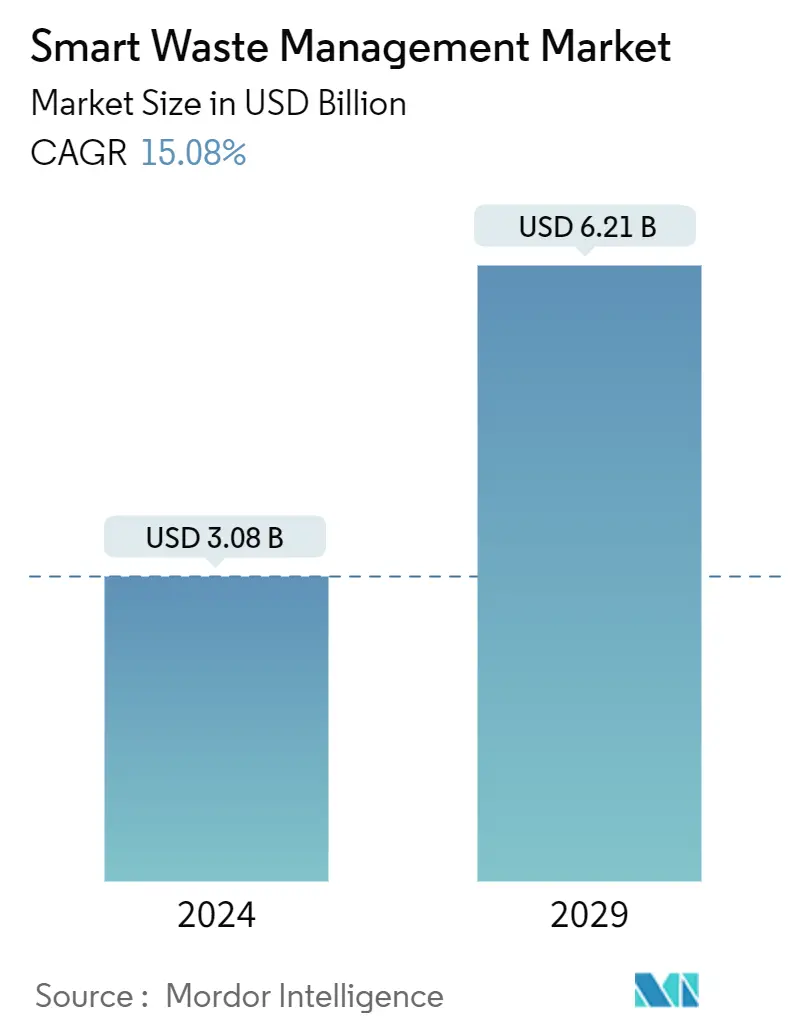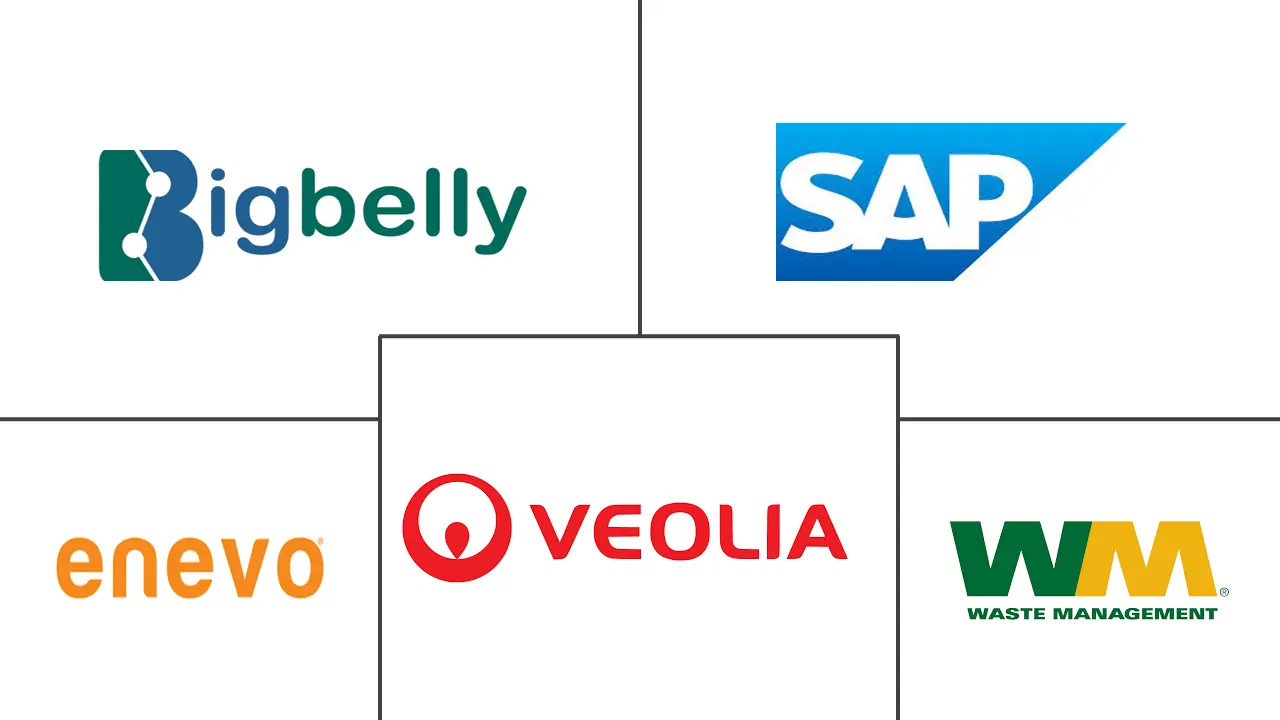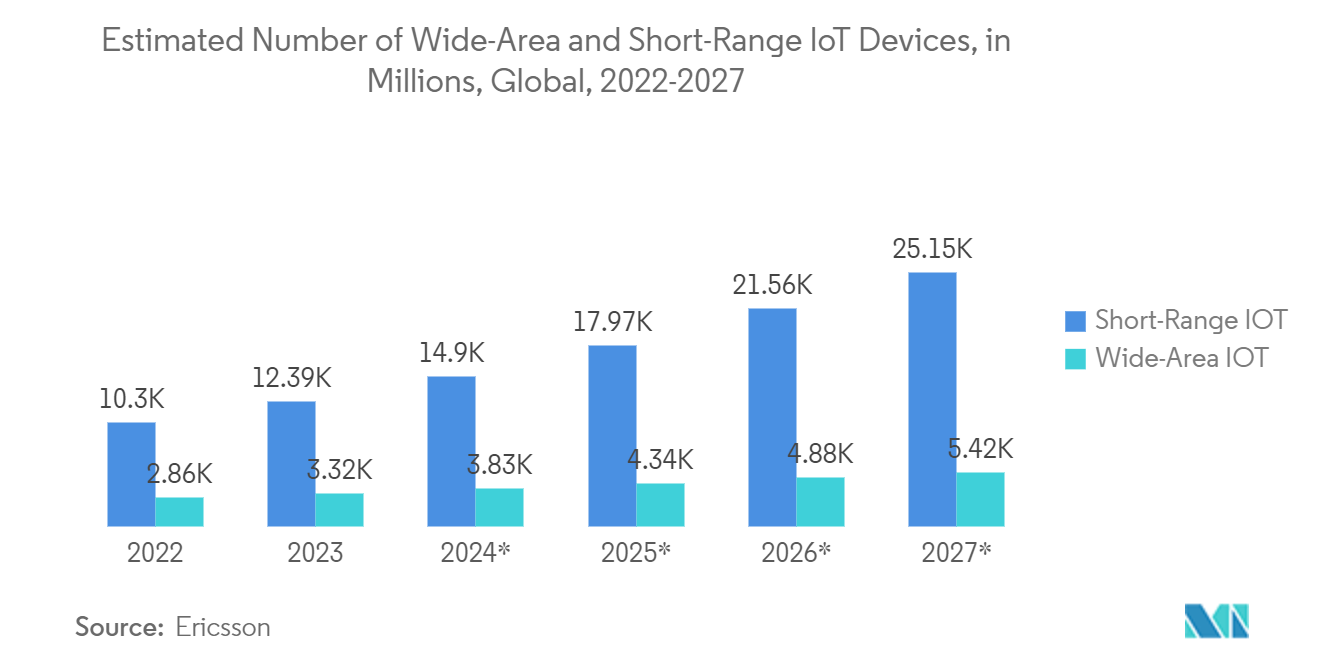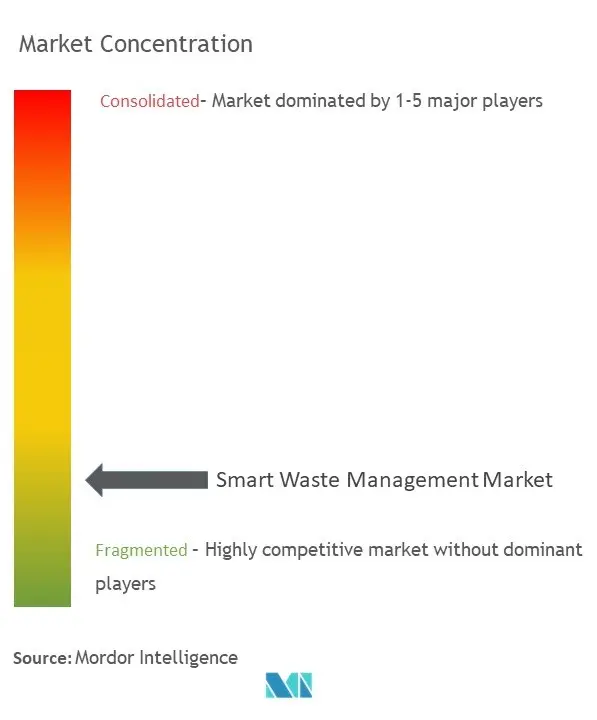Smart Waste Management Market Size

| Study Period | 2019 - 2029 |
| Market Size (2024) | USD 3.08 Billion |
| Market Size (2029) | USD 6.21 Billion |
| CAGR (2024 - 2029) | 15.08 % |
| Fastest Growing Market | Asia Pacific |
| Largest Market | North America |
Major Players
*Disclaimer: Major Players sorted in no particular order |
Smart Waste Management Market Analysis
The Smart Waste Management Market size is estimated at USD 3.08 billion in 2024, and is expected to reach USD 6.21 billion by 2029, growing at a CAGR of 15.08% during the forecast period (2024-2029).
Smart waste management directs the use of sensors in waste to observe the real-time status of municipal waste collection services and decide when bins should be emptied or filled. It also maintains track of past information collected by sensors and databases that can be utilized to pinpoint and enhance driver routes, fill patterns, and lower operating costs. Effective waste collection is more functional with remote monitoring and IoT-based waste bins. Urbanization and rapid industrialization are the two main drivers of the smart waste management market. Therefore, the volume of waste from the municipal and industrial sectors has grown. The routine collection and disposal of waste have risen due to rising environmental awareness.
- Smart waste management is crucial in developing smart cities (along with water management, traffic management, energy management, etc.) to improve lifestyles in urban areas. The increasing adoption of innovative city initiatives across regions helps the smart waste management market’s growth. The waste management industry involves diverse activities, such as collection, disposal, transportation, and recycling. The industry has been facing efficiency problems at different stages of waste management. The operational costs equal the collection and transport of the waste, thereby increasing the adoption of smart waste management.
- In recent years, owing to the growing population and urbanization, the global demand for waste management and the demand to address the cost implications of maintaining an aging infrastructure have been among the primary motivating factors for the smart waste management market’s growth.
- Moreover, the development of the smart waste management market has been assisted by products like disposable tags, containers, and vacuum cleaners that contain real-time waste management systems. The rising usage of waste management systems also results from growing environmental concerns.
- However, the lack of skilled laborers worldwide is expected to increase maintenance costs as most of them have to travel down to the service areas and resolve issues. Nevertheless, the growing focus on remote management may reduce the cost burden during the forecast period.
Smart Waste Management Market Trends
Analytics Sector to Witness Major Growth
- Waste management has become a crucial issue for cities worldwide in the era of technological advancements and rapid urbanization. Smart waste management has emerged as a promising solution. Fleet management plays a central role in smart waste management systems.
- Fleet management solutions often refer to systems that offer greater control over fleet activities using data communications, logging, and analytics. FMS's various services include vehicle and asset management, operation management, supply chain management, and regulatory compliance. Deploying fleet management solutions reduces factors that account for a significant portion of fleet operation spending, such as fuel costs. Thus, by the benefits they provide, FMS minimizes the cost of fleet operation.
- Fleet management in smart waste management encompasses a range of activities, including monitoring and tracking waste collection vehicles, route optimization, maintenance scheduling, and performance analysis. One of the crucial components of fleet management in this context is using GPS and Internet of Things technologies; according to Ericsson, the adoption number of short-range Internet of Things (IoT) devices is forecast to increase to 25 billion by 2027. and wide-area IoT devices are predicted to reach 5.4 billion by 2027 and used to track the location and movement of waste collection vehicles in real-time
- By equipping these vehicles with GPS devices and sensors, waste management authorities can gain valuable insights into their operations' efficiency, identify improvement areas, and respond immediately to any issues that may arise during the collection process. Moreover, the integration of route optimization software into fleet management systems enables waste management authorities to plan more efficient routes.

North America Holds Largest Market Share
- Smart cities in the United States use smart waste management solutions more frequently to solve waste collection and disposal issues, which is expected to boost market sales. In addition, strict rules governing the reduction of carbon emissions across the country are anticipated to drive market sales in the coming years. The increasing government's efforts to promote sustainability and achieve net-zero waste will continue to drive up demand in the area.
- Cities in the United States are already implementing strategic programs. The country alone contributes most of the yearly waste produced, with around 230 million metric tons of trash, a significant chunk of which private entities handle. The United States is expected to account for a significant share of the smart waste management market due to government initiatives promoting sustainability and the penetration of smart city initiatives across the high urban concentration region.
- The industrial sector's increased production creates a demand for smart management solutions. The chemical manufacturing industry manages over half (55%) of all TRI chemical waste. According to the BEA, in 2022, the value added from producing chemical products reached approximately USD 501.39 billion, which was USD 447.55 billion in 2021. This demonstrates a substantial increase in the value generated by the chemical industry in the United States.
- Canada's population continues to grow steadily, driven by immigration, natural population increase, and urbanization. As the population expands, so does the overall demand for goods, services, and infrastructure, leading to increased waste generation. As per StatCan, currently, annual immigration in Canada amounts to almost 500,000 new immigrants, which is one of the highest rates per population of any country in the world. As of 2023, there were more than eight million immigrants with permanent residence living in Canada, roughly 20% of the total Canadian population.
- Companies in the country are finding new ways to manage waste sustainably while cutting costs. The changes include integrating sensors and other cloud-based technologies to reduce waste volumes and optimize service levels. Companies are also measuring the carbon footprint of the waste produced to reduce greenhouse gas emissions.
- The country is working towards eliminating the excessive use of single-use plastics in government operations, events, and meetings and purchasing more sustainable plastic products that can be repaired, reused, or repurposed. By 2030, the government aims to extend product life and remove at least 75% of plastic waste from public administrations.

Smart Waste Management Industry Overview
The Smart Waste Management Market is fragmented. The vast expansion of capabilities in smart connected products may tempt companies to keep up with rivals and give away too much improved product performance. This environment escalates costs and erodes industry profitability. Some of the key players in the market are SAP SE, Veolia Environmental Services, Enevo, Waste Management Inc., and Bigbelly Inc.
- October 2023 - Veolia continues Hong Kong's ecological transformation and the regeneration of its resources, following the award of a historic EUR 2 billion contract to dispose of the city's non-hazardous waste. With a presence in Hong Kong for over 30 years and more than a thousand employees, the Group is working locally to decarbonize the city's activities through multiple water, waste, and energy contracts to accelerate the local ecological transformation.
- September 2023 - WM has opened a new 100,000-square-foot recycling facility in Cleveland, Ohio. The facility has the latest technology and can process up to 420 tonnes of recyclables daily. WM’s new recycling facility technology, which includes glass recovery equipment, an optical sorter, a non-wrapping screen, and ballistic separators, is designed to support the growth of recycling programs in the region and the production of high-quality material for customers who use recycled material as raw material to create new products.
Smart Waste Management Market Leaders
-
SAP SE
-
Veolia Environmental Services
-
Enevo
-
Waste Management Inc.
-
Bigbelly Inc.
*Disclaimer: Major Players sorted in no particular order

Smart Waste Management Market News
- July 2023 - WM began operations at its new USD 35 million, 14,500 square foot renewable natural gas plant located at the Texas-based company’s Eco Vista landfill, the company said in a news release. Construction on the new facility began two years ago, and the company plans to employ 125 construction workers and four workers to manage the facility, which will have a capacity of 14,500 square feet. The company said the new facility is expected to be fully operational by the end of May.
- June 2023 - The Government of India supported the second phase of the City Investments to Innovate, Integrate, and Sustain (CITIIS) project, a program under the ambit of the Smart Cities Mission, which aims to encourage blended waste management and climate-oriented reform actions. The CITIIS 2.0 will be executed in 18 cities.
Smart Waste Management Market Report - Table of Contents
1. INTRODUCTION
- 1.1 Study Assumptions and Market Definition
- 1.2 Scope of the Study
2. RESEARCH METHODOLOGY
3. EXECUTIVE SUMMARY
4. MARKET INSIGHTS
- 4.1 Market Overview
-
4.2 Industry Attractiveness - Porter's Five Forces Analysis
- 4.2.1 Bargaining Power of Suppliers
- 4.2.2 Bargaining Power of Buyers
- 4.2.3 Threat of New Entrants
- 4.2.4 Threat of Substitutes
- 4.2.5 Intensity of Competitive Rivalry
- 4.3 Impact of COVID-19 Aftereffects and Other Macroeconomic Factors on the Market
5. MARKET DYNAMICS
-
5.1 Market Drivers
- 5.1.1 Increasing Volumes of Waste to Boost the Market
- 5.1.2 Rising Adoption of Smart Cities to Flourish the Market
-
5.2 Market Challenges
- 5.2.1 High Costs of Implementation
6. Technology Snapshot
- 6.1 Technology Overview
- 6.2 Innovative Technologies Revolutionizing Waste Management
- 6.3 Smart Waste Management Stages - By Connectors
- 6.4 Application of Sensors in the Smart Waste Management Market
-
6.5 Smart Waste Management Stages
- 6.5.1 Smart Collection
- 6.5.2 Smart Processing
- 6.5.3 Smart Energy Recovery
- 6.5.4 Smart Disposal
7. MARKET SEGMENTATION
-
7.1 By Solution
- 7.1.1 Fleet Management
- 7.1.2 Remote Monitoring
- 7.1.3 Analytics
-
7.2 By Waste Type
- 7.2.1 Industrial Waste
- 7.2.2 Residential Waste
-
7.3 By Geography
- 7.3.1 North America
- 7.3.1.1 United States
- 7.3.1.2 Canada
- 7.3.2 Europe
- 7.3.2.1 Germany
- 7.3.2.2 United Kingdom
- 7.3.2.3 France
- 7.3.2.4 Spain
- 7.3.2.5 Italy
- 7.3.3 Asia
- 7.3.3.1 India
- 7.3.3.2 China
- 7.3.3.3 Australia
- 7.3.3.4 Japan
- 7.3.3.5 Australia and New Zealand
- 7.3.4 Latin America
- 7.3.5 Middle East and Africa
8. COMPETITIVE LANDSCAPE
-
8.1 Company Profiles*
- 8.1.1 SAP SE
- 8.1.2 Veolia Environmental Services
- 8.1.3 Enevo
- 8.1.4 Waste Management Inc.
- 8.1.5 Bigbelly Inc.
- 8.1.6 Covanta Holding Corporation
- 8.1.7 Evoeco
- 8.1.8 Pepperl+Fuchs GmbH
- 8.1.9 IBM Corporation
- 8.1.10 BIN-e
9. INVESTMENT ANALYSIS
10. FUTURE OF THE MARKET
** Subject To AvailablitySmart Waste Management Industry Segmentation
The process of implementing a technique used to monitor the collection, disposal, and transportation of waste material services for efficient waste management operations is known as smart waste management. This relates to the Internet of Things (IoT), which includes numerous cameras, portable computers, and other devices.
The smart waste management market is segmented by solution (fleet management, remote monitoring, analytics), waste type (industrial waste, residential waste), and geography (North America (United States, Canada), Europe (Germany, United Kingdom, France, Italy, Spain, and Rest of Europe), Asia Pacific (India, China, Japan, Australia, and Rest of Asia-Pacific), and Rest of the World). The market size and forecasts are provided in terms of value (USD) for all the above segments.
| By Solution | Fleet Management | |
| Remote Monitoring | ||
| Analytics | ||
| By Waste Type | Industrial Waste | |
| Residential Waste | ||
| By Geography | North America | United States |
| Canada | ||
| By Geography | Europe | Germany |
| United Kingdom | ||
| France | ||
| Spain | ||
| Italy | ||
| By Geography | Asia | India |
| China | ||
| Australia | ||
| Japan | ||
| Australia and New Zealand | ||
| By Geography | Latin America | |
| Middle East and Africa |
Smart Waste Management Market Research FAQs
How big is the Smart Waste Management Market?
The Smart Waste Management Market size is expected to reach USD 3.08 billion in 2024 and grow at a CAGR of 15.08% to reach USD 6.21 billion by 2029.
What is the current Smart Waste Management Market size?
In 2024, the Smart Waste Management Market size is expected to reach USD 3.08 billion.
Who are the key players in Smart Waste Management Market?
SAP SE, Veolia Environmental Services, Enevo, Waste Management Inc. and Bigbelly Inc. are the major companies operating in the Smart Waste Management Market.
Which is the fastest growing region in Smart Waste Management Market?
Asia Pacific is estimated to grow at the highest CAGR over the forecast period (2024-2029).
Which region has the biggest share in Smart Waste Management Market?
In 2024, the North America accounts for the largest market share in Smart Waste Management Market.
What years does this Smart Waste Management Market cover, and what was the market size in 2023?
In 2023, the Smart Waste Management Market size was estimated at USD 2.62 billion. The report covers the Smart Waste Management Market historical market size for years: 2019, 2020, 2021, 2022 and 2023. The report also forecasts the Smart Waste Management Market size for years: 2024, 2025, 2026, 2027, 2028 and 2029.
What are the opportunities for growth in the Smart Waste Management Market?
Growth opportunities in the Smart Waste Management Market include: a) Expanding into emerging markets b) Developing more cost-effective solutions c) Integrating advanced technologies for better waste management
Smart Waste Management Industry Report
The global smart waste management market is on the rise, fueled by the growth of smart cities and the need for efficient waste solutions in residential, commercial, and public sectors. With increasing waste generation and the urgent need for environmentally safe management, investing in smart technologies like RFID tags, sensor-based containers, and vacuum systems is crucial. These innovations enable real-time tracking and management, cutting costs in collection and transportation. The smart waste collection market, in particular, benefits from advanced technology, enhancing operations and reducing expenses. Opportunities are expanding with the adoption of IoT technologies, streamlining logistics and minimizing operational costs. Despite challenges like lack of awareness and high initial investments, the market's growth is robust, driven by smart city developments and the demand for sustainable solutions. For detailed insights, Mordor Intelligence™ offers a comprehensive analysis, including market share, size, revenue growth, and forecasts in a free report PDF download.



